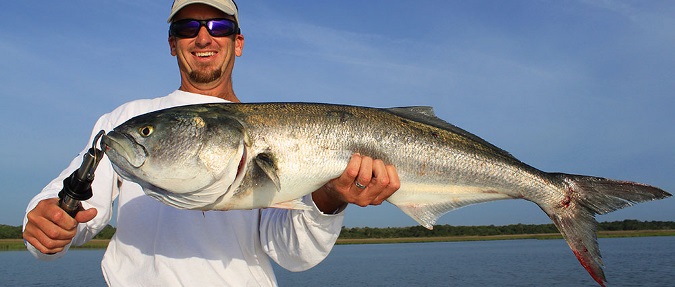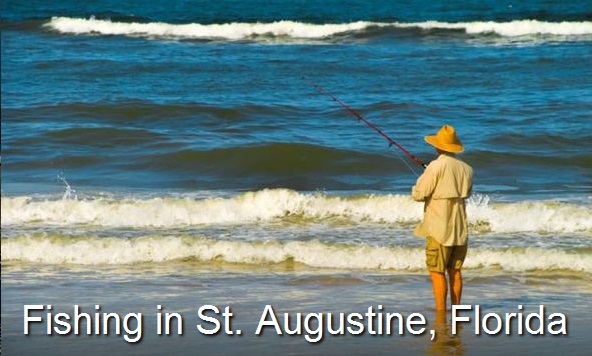
When you ask people about their favorite fish species in Florida, you will undoubtedly get a wide array of answers—from the ever popular redfish and spotted seatrout found in inshore waters, to the snappers and groupers found on Florida’s many offshore reefs, to the billfish and dolphin found in Florida’s blue water.
These are some of the classic species that make fishing in Florida so popular. Personally though, I’ve always been a fan of the oddballs, the underdogs, and the perhaps less sought after but definitely worth the effort fish. In this case, I’m talking about bluefish.
Now, I’m not trying to diminish the beloved popular species listed above in any way; they’re all popular for good reasons and I wouldn’t pass up a fishing trip for any one of them. Having said that, let me explain why bluefish hold a special place in my heart, and why they might be worth spending a little extra time chasing.
My first memory of bluefish goes back to my childhood, fishing in New England with my dad in our 17-foot Boston Whaler. We were fishing for the usual fare, summer flounder and porgy, but there was one big rod set off the back of the boat, rigged with heavy tackle and baited with a fish I deemed too small to keep, but was too large to be bait for any normal-sized fish. I remember asking my dad what kind of fish would eat something that big. The tone of his voice gave me the impression that bluefish were something very special. 
If you are not familiar with bluefish, I admit at first glance they can look like just another generic silver fish. Hardly worthy of the reverence in my father’s voice that day or worthy of the substantial rod and tackle deployed to capture it. Coupled with the frequent distinction of being too oily or fishy for most typical fish dishes, it’s not hard to see why these guys may not be winning the popularity contest in Florida. But, there are more to bluefish than meets the eye.
Bluefish, or Pomatomus saltatrix as they’re known in the scientific community, are a one-of-a-kind fish. They are the only living fish species in their family, which means that nothing else in the ocean looks, tastes or fights like a bluefish. Take notice of their razor-sharp pointed teeth, used for chomping and tearing large bites out of their desired prey items. Examine further their ferocious behavior, in a feeding aggregation known as a “bluefish blitz,” churning the water so violently it resembles a washing machine. Add to that the stamina to migrate from New England to Florida and back again each year, and that bluefish starts sounding like quite the formidable opponent, especially at sizes in excess of 36 inches. Don’t be fooled though, even those little ones pack a mean punch; they are nicknamed “snappers” for a reason.
Beginning to sound more like a fish you’d want on the end of your line? Well, once the water cools off around November and December, find yourself a decent inlet, shoal or rip with some lively bait schooling action and drop a line. They’ll take a nice-sized plug just as readily as they will live or cut bait. You’ll also want to make sure your fishing tackle is heavy enough to combat one of these power machines, and you are using a leader strong enough to stand up to those sharp bluefish chompers.
If you’re willing to give them a whirl, there are some great recipes spanning a number of different cuisines (bluefish are found across the globe in Australia, Africa, Southeast Asia and the Mediterranean, just to name a few). You’ll also want to make sure to eat them soon after catching since, as top predators, they have strong digestive enzymes that cause their meat to have a short shelf life.
Still not convinced they’ll be the best table fare? Catch-and-release is a great option too, just make sure to minimize handling and get them back in the water quickly.
Want to get more bang for your bluefish? Check out the Florida Fish and Wildlife Conservation Commission’s (FWC) Saltwater Angler Recognition programs at CatchaFloridaMemory.com. You can add your bluefish catch to your Saltwater Fish Life List or apply for a Reel Big Fish certificate if your bluefish is 35 inches or longer.
For more about bluefish, visit MyFWC.com/WildlifeHabitats and click on “Species Profiles,” “Saltwater” and “Bluefish.”
Send your questions, photos, and fishing tales to Saltwater@MyFWC.com. Make sure your photo meets our photo requirements by visiting MyFWC.com/Fishing, clicking on “Saltwater Fishing,” scrolling down to “Get Involved” and clicking on “Submit a Photograph.” Learn more about our Saltwater Angler Recognition Programs and how you can “Catch a Florida Memory” by visiting MyFWC.com/AnglerRecognition or contacting AnglerRecognition@MyFWC.com. And don’t forget to record all of your catches on the iAngler phone app or at SnookFoundation.org.
Gone Coastal is one of many ways that the FWC Division of Marine Fisheries Management is helping recreational anglers understand complex saltwater regulations and learn more about saltwater fishing opportunities and issues in Florida. We are also available to answer questions by phone or email anytime, and we would love the opportunity to share information through in-person presentations with recreational or commercial fishing organizations. To contact the FWC’s Regulatory Outreach subsection, call 850-487-0554 or email Saltwater@MyFWC.com.
